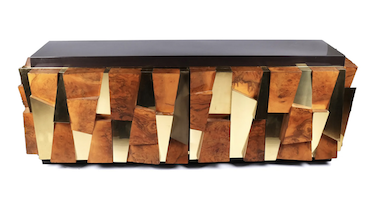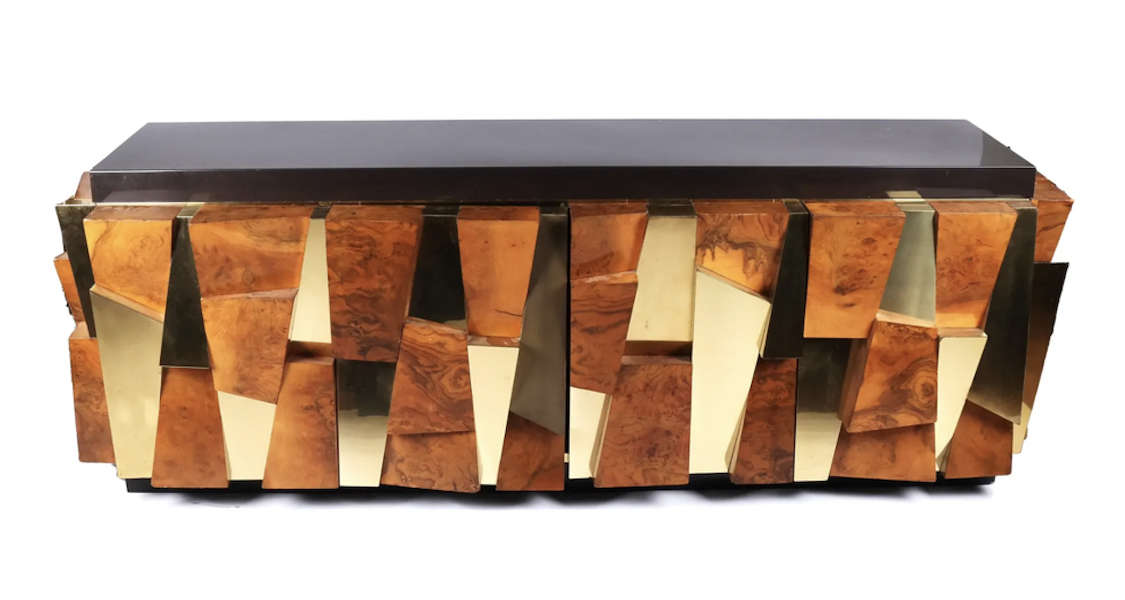
NEW YORK — A sideboard is a piece of furniture that has a flat top and drawers in which to store linens or dining ware, but it can be so much more than that. Elite Mid-century Modern artisans seized upon the sideboard’s potential and transformed this dining room workhorse into a work of art.
Robert Adam is credited as developing the sideboard in the 18th century as an offshoot of the table. This stolid, eminently useful type of furniture has also been referred to as a buffet or a credenza. Early on, it was a status piece in affluent homes but it has since become a more common and more widely used item.
While the sideboard has been produced in styles ranging from Victorian and Georgian to Federal and Hepplewhite, it reached its zenith in the Mid-century Modern period. Innovative furniture designers such as Paul Evans, Tommi Parzinger, Wendell Castle, Philip and Kelvin LaVerne, Hans Wegner and Arne Vodder experimented with materials and design to revolutionize the form. They made the sideboard’s feet a focal point, or removed them altogether; they added three-dimensional surfaces, mixed metals and lacquer, forever changing the look of this once-staid item.

Castle was among the most revolutionary, pushing the sideboard so far past the realm of functional art that it might as well be sculpture. A circa-1976 custom sideboard in cherry by Castle made $95,000 plus the buyer’s premium in May 2022 at Rago Arts and Auction Center. Created near the end of the Mid-century Modern era, he harnessed all his skills to craft this piece that challenges the very notion of what a sideboard can be. The organic form of the radical design is enhanced by its exquisite wood grain. The piece lacks feet and a flat top. Instead, at its center point, it thrusts upward like a hand reaching for the sun.
“As for sideboards, it’s interesting that regardless of how radical some of the work became, we can still see how much of it centered on traditional functions like dining rooms and atomic family meals together,” said David Rago, partner and co-director at Rago Arts & Auction Center in Lambertville, New Jersey. “The sideboard has been around as long as people have made or could afford furniture, regardless of societal change. The modernists found new ways to provide the same function. Curves, color, new materials, hidden compartments, and yet none of it impeded functionality.”
Rago notes that while Castle’s custom sideboard might seem late for a mid-century work, the high-end craft movement didn’t really kick in until the 60s. “I think American designers had to first find their own voices, and the work they were doing earlier spoke more of where ideas and influences came from than where they were headed. The 60s were a heady time in a lot of ways, obviously, and in design it often revealed how a younger generation, the boomers, were to emerge from the constraints of traditional art.”
Famous for his daring sideboards featuring sculptural fronts or highly mirrored surfaces that have been called “stunningly beautiful” by fans and “tacky” by detractors, Paul Evans elevated the sideboard to an art form. A popular model was the Cityscape sideboard for Directional, which was evocative of the disco era. An example juxtaposing fractured brass and walnut elements on the front earned $40,000 plus the buyer’s premium in September 2022 at Roland NY.
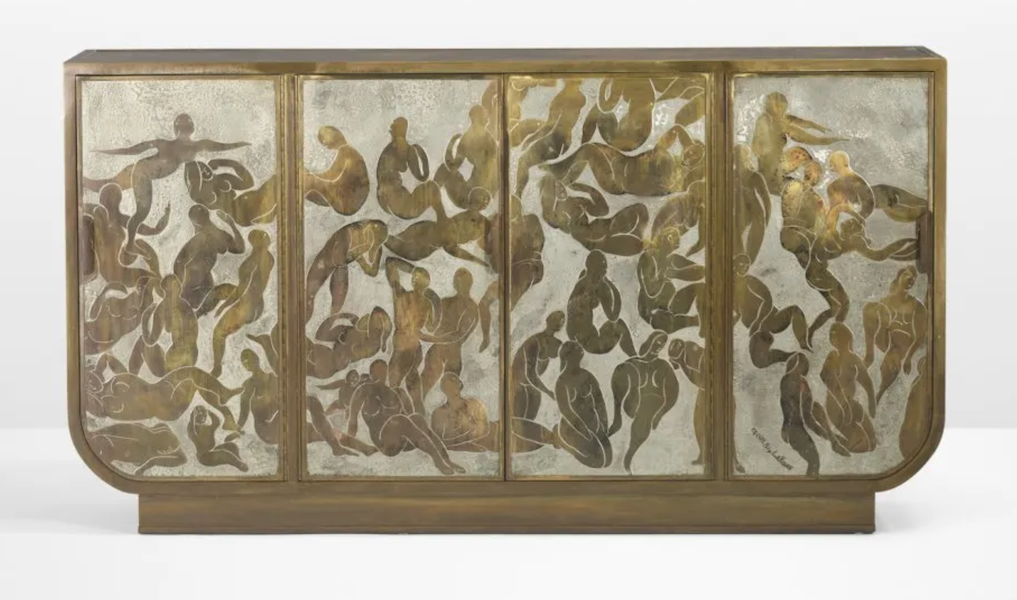
Other Mid-century Modern designers who placed their own spin on the sideboard were the father-and-son team of Philip and Kelvin LaVerne. Among their most distinctive pieces was the Bather’s sideboard or cabinet that they unveiled in the mid-60s and produced well into the 1970s. A circa-1968 example featuring acid-etched brass along with enameled and patinated brass over pewter and wood sold for $85,000 plus the buyer’s premium in November 2016 at Wright. The two reportedly achieved the look that ancient bronzes acquired naturally during the course of centuries in about six weeks through a technique that they kept secret.
The LaVernes produced their Bather’s sideboard in smaller numbers than, say, tables due to the complexity and time involved in creating such a piece. Moving on from the chinoiserie and Egyptian decorative styles that inspired the duo’s earlier work, this sideboard comes “from a rare series of motifs within the oeuvre of the artists inspired by renowned works of fine art as diverse as Picasso, Dali and Michelangelo,” according to Wright’s catalog description of the sideboard.
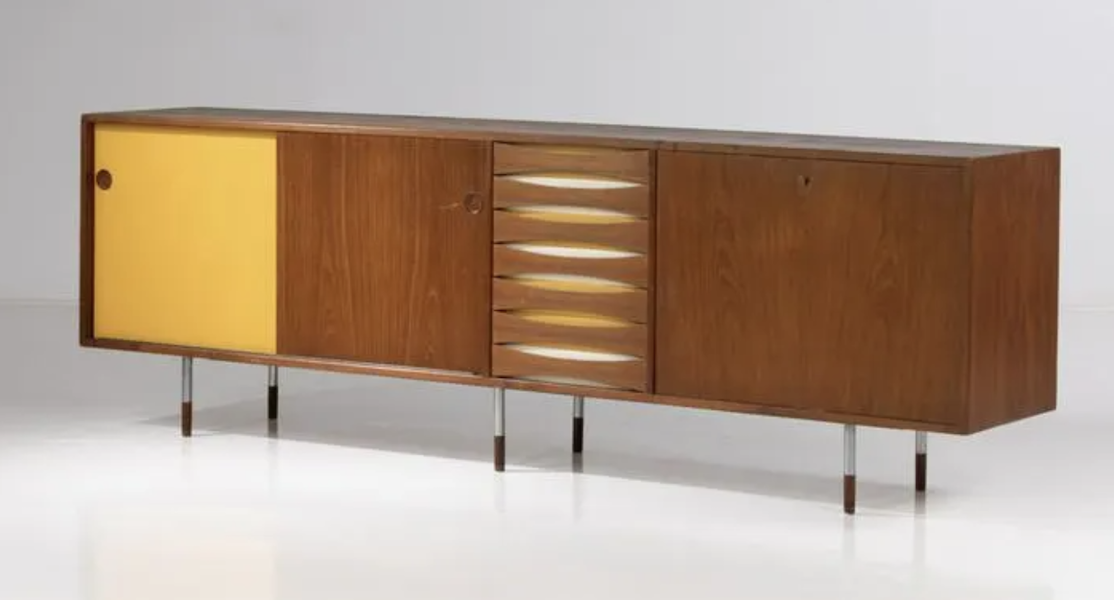
Trained by Finn Juhl, Danish furniture designer Arne Vodder also had a key role in shaping the Mid-century Modern aesthetic. He was known for designing furniture that was highly functional but had soft lines. His sideboards typically included beveled drawers with inset detailing features that served as hidden drawer pulls. An example in teak, metal and lacquered wood of a model he debuted in 1959 sold for €14,000 (about $15,081) plus the buyer’s premium in June 2021 at Piasa.
Arriving in New York from Germany in 1932, Tommi Parzinger was a talented craftsman and designer known for his pieces with sleek lines in fine woods such as walnut and mahogany. A fitting example of his style is a lacquered mahogany sideboard with maple inlay and brass hardware from the 1960s that realized $9,500 plus the buyer’s premium in February 2016 at Rago Arts and Auction Center.
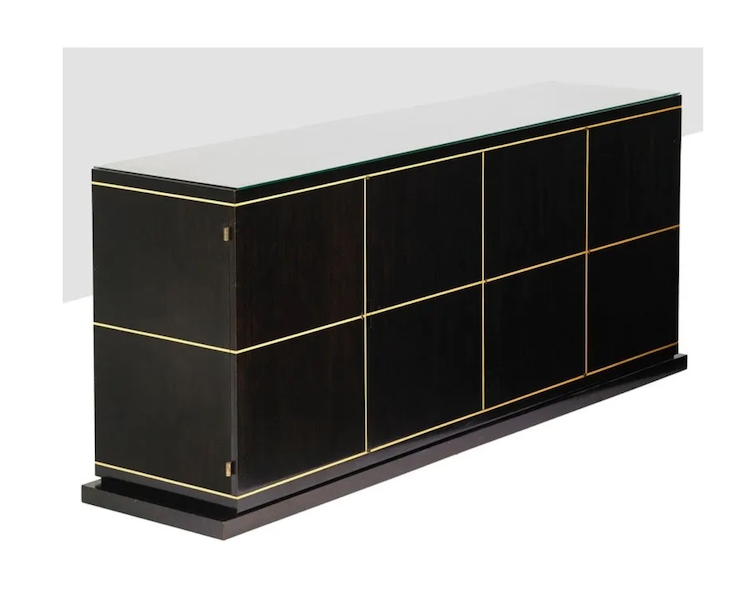
Experimental and sophisticated sideboards such as these have helped Mid-century Modern furniture remain a hot category for years. While the flatware and porcelain that once filled them is not nearly as in demand, and dinner parties are not as popular or routine as they were in the mid-20th century, the sideboards from this era have not gone out of style. They continue to earn pride of place in contemporary dining rooms, even if their only purpose is to sit there and look spectacular.


